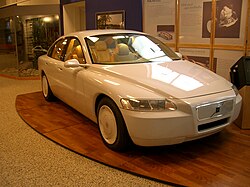
Summary
The Volvo ECC (Environmental Concept Car) was an executive luxury concept car built by Volvo in 1992.[1] It was a design exercise in using recycled material and hybrid technology.[2] It was powered by a hybrid electric and gas turbine engine. Many of its lines and general styling were used as inspiration for the first generation Volvo S80.[3] The ECC set a new design language for future Volvo models from the S80 onwards, the most obvious styling feature being the stepped waistline, which was inspired by the similar feature on the 200 Series, whilst retaining some of the angular elements from the 700/900 ranges.


The Volvo ECC was built on the Volvo P80 platform.[1][3] In contrast to most production hybrids, which use a gasoline piston engine to provide additional acceleration and to recharge the battery storage, the Volvo ECC used a gas turbine engine to drive the generator for recharging. This type of engine has a higher thermodynamic efficiency than the conventional internal combustion engine with pistons. Also in Volvo's design, the fuel is evaporated and mixed with air before ignition. This provides a very low NOx emission. The driver can also switch between gas turbine electric and hybrid by switches on the dashboard.
The maximum power available was 95 bhp (71 kW; 96 PS),[4] with 76 available for continuous use.[4] It had a drag coefficient of 0.23.[3] With the vehicle weighing approximately 1,580 kg (3,483 lb)[3][4] more than a conventional Volvo 850, acceleration from 0-60 mph (97 km/h) took 23 seconds in EV mode and 12.5 seconds with the turbine engaged.[5] Top speed was 109 mph (175 km/h). The vehicle's range on batteries alone was 90 mi (145 km), and when combined with a full tank of fuel for the turbine, about 415 mi (668 km).[6]
The Volvo ECC was debuted at a time when California was seeking Zero Pollution Vehicles (ZPV).[when?] With its gas turbine, the Volvo ECC was not a zero-emissions vehicle, and hence did not meet the needs of the time. With the focus now[when?] shifted away from true zero-emissions vehicles, many of the concepts tested in the ECC may prove of value in future concept and production vehicles.

References edit
- ^ a b Ronan Glon (2 September 2014). "1992 Paris Motor Show: Volvo introduces the Environmental Concept Car". ranwhenparked.net. Retrieved 2017-08-06.
- ^ Owen Ready (11 December 2015). "Concept Car of the Week: Volvo ECC (1992)". www.cardesignnews.com. Retrieved 2017-08-06.
- ^ a b c d Volvo Car Corporation (1 March 2005). "Volvo ECC – the car that gave the world a preview of Volvo's future already back in 1992". media.volvocars.com. Retrieved 2017-08-06.
- ^ a b c Len Frank. "Volvo Environmental Concept Car - Driving the Future". www.lacar.com. Retrieved 2017-08-06.
- ^ Ron Cogan (February 1993). "Volvo Hybrid Environmental Concept Car". www.greencar.com. Archived from the original on 2009-05-04. Retrieved 2017-08-06.
- ^ Len Frank (January 1994). "Volvo's environmental turbine car". Popular Science. p. 48. Retrieved 2017-08-06.
External links edit
- Trafikmagasinet visar Volvo ECC
- Om Volvo ECC på Volvocars.com
- Volvo Hybrid Environmental Concept Car
Volvo C30 ReCharge Concept
- Om Volvo ReCharge Concept diesel på Volvocars Newsroom
- Om Volvo ReCharge Concept flexifuel på Volvocars Newsroom


